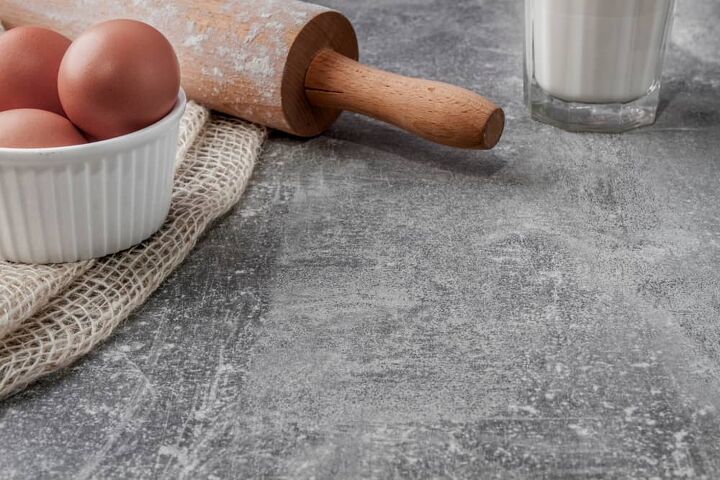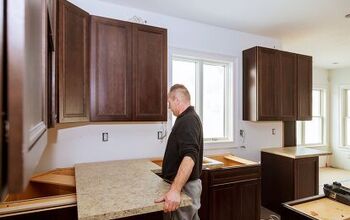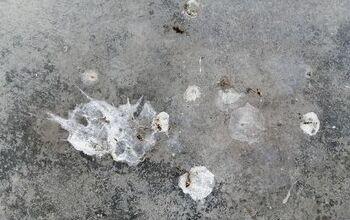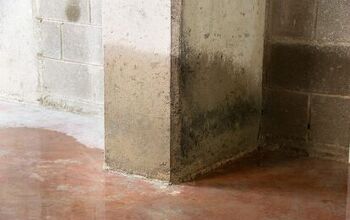How To Seal Concrete Countertops (Quickly & Easily!)

One of the hottest new trends to hit the world of kitchen design is concrete countertops. They’re chic, modern, and oh, so industrial. However, they are also fairly difficult to install. Along with having to pour your own concrete to create the countertop, you need to seal them in order to keep them sanitary. The question remains, how?
Sealing concrete is a multi-step approach, and it’s one that requires a fair amount of work. To seal a countertop, do the following:
- Put the countertop in a sealer-friendly environment.
- Mix the concrete countertop sealer per the instructions on the box.
- Soak the countertop in water, and dry it.
- Apply the sealer.
- Clean up, and spot test the counter.
This is not the type of project that should be taken lightly. It will make or break your ability to enjoy your countertop later on, not to mention affect the quality of your food prep. This guide is here to help.
Do You Need Countertop Installers?
Get free, zero-commitment quotes from pro contractors near you.

Sealing Your Concrete Countertop
Sealing your countertop needs to be done carefully. Each step has its own nuances you need to be aware of, too. We’ll discuss things in a little more detail below.
1. Choose Your Sealing Environment
The first thing you need to know is that you shouldn’t do this in your kitchen, as spilled sealant can be a pain to clean off your floor. Rather, it’s better to do this in a garage. You should do this in a shady, dust-free environment away from heavy drafts. You do not want the sealer to dry too soon.
If you have the space to do so, prop your countertop counter-side up on a pair of saw horses. Put a plastic sheet under the sawhorses, so that the sheet can catch any drippings that occur. This will make it easier for you to wipe things down.
2. Mix Your Sealer
When you’re shopping around for a sealer, it’s important to seek out a sealer that is specifically made for concrete countertops. Otherwise, there is a chance that you won’t get good results, or worse, that the countertop could become a hazard for your family’s health. I mean, it’s not like you’re going to have the same sealer for the concrete slab your bathroom’s plumbing will run through.
Every sealer has its own use instructions, and that includes concrete sealers. Most will require you to mix your sealer with water in order to dilute it. Don’t skip that step! Doing this is the only way to get the consistency you need. So, don’t deviate from the instructions, either.
3. Prep Your Countertop
Concrete countertops can’t just be sealed willy-nilly. Here’s how you can properly prepare your countertop for a new coat of sealant.
- If your countertop already had a coat of sealant and wax, strip the old layers. You can do this by applying mineral spirits to the countertop. Wipe the countertop (and its edges) down with a rag soaked in the stuff, then move to step two.
- Get several clean rags and soak them in water. In fact, you can pour water on top of the counter too! You want to thoroughly soak the surfaces that you want to seal.
- Keep soaking the countertop until the concrete is darkened. Now, you’re ready to start applying the sealant!
4. Apply The Sealant
Sealing your concrete countertop becomes fairly easy after the soaking period. Just take a new rag, dip it in a bucket of the sealant mixture that you made, and wipe down the counter. Keep wiping it down, adding sealant liberally. Make sure you don’t miss any spots like the corners or edges, as it will start to look uneven.
Applying your sealant is best done with thin layers, which is why it makes sense to dilute your sealant prior to application. You will need at least three layers in order to get appropriate coverage. Let the sealant soak into the concrete for at least five minutes, then give it an extra wipe.
5. Clean Up
The thing about sealing concrete is that excessive sealant isn’t a good thing either. With every application you make, you will need to wipe off the excess, letting it fall into the sealant bucket. Once the excess has been dropped into the bucket, you can start another layer of sealant.
Once you have finished covering your countertop with several layers of thin, uniform sealant, let it dry for 24 hours. If things went well, you should be done. Cap your sealant bucket. However, there’s still one thing you need to do before you can assume it’s all properly sealed…
6. Do A Spot Test
After you’ve let the sealant cure for a day, it’s time to give your counter a spot test. Doing this is simple. Here’s how to do it:
- Take a large glass of water and dump it on the countertop, spreading it around the top liberally. Don’t be shy, here.
- Let the water sit on the counter for 10 minutes. Now would be a good time to read up on some tips on setting the height of your bar counter right, if you’re giving your man cave a makeover. This is to ensure that any holes in the sealant will have adequate time to make themselves known.
- Grab a rag and soak up the water. You want to dry out your counter as much as you can.
- Look at the counter. If things are done correctly, you should not see any dark spots on your counter. If you see some darkening, it’s time to add some more sealant.
7. (Optional) Switch Up Your Counter Texture
Once your counter is sealed, it’s up to you to decide what kind of texture you want to give it. You can, of course, keep it smooth. If you want to make your counter extra snazzy, you can also get some hurricane pads to burnish it and add extra shine.
Do You Need Countertop Installers?
Get free, zero-commitment quotes from pro contractors near you.

Related Questions
How soon can you seal a concrete countertop?
This depends on the type of sealant you’re using as well as the slab you’re sealing. You need to wait until the concrete is completely cured, at the very least. Most concrete countertop sealants are ready to use in as little as 10 days after pouring. Some can even be used in as little as five days after the pour. You can figure out how long you have to wait by referring to the packaging on the sealant.It’s worth noting that there is one type of sealant that takes longer to use than the others. That type is epoxy sealant. Since the consistency of this sealant is so much thicker than others, you may need to wait up to a month after pouring to seal it. If you aren’t sure when you can use the sealant, it’s best to wait 28 days just to be safe.
Is polyurethane a safe material to use as a concrete sealer?
Polyurethane sealers are temperature-resistant and non-toxic. That makes them a sterling choice for countertops, including those made of concrete. Most people who choose polyurethane sealant do so because it can be used on both exterior and interior panels, and because it doesn’t turn yellow as years pass.If you choose to use a polyurethane coat, you’re in for a durability-related treat. Polyurethane sealants can last up to 10 years with careful maintenance.
Are concrete countertops easy to maintain?
While they may be impressive to look at, concrete countertops are fairly hard to maintain. Along with regular cleaning, you will need to re-apply sealant and wax on a semi-regular basis. Because concrete countertops are more prone to staining than most other countertop materials, you need to address any spills you get as soon as they happen.Truth be told, most people won’t find a concrete countertop to be easy to maintain. This is one of the key reasons why they are not taking the interior design world by storm. However, there is some hope. Sealant companies are currently working on improving their formulas with concrete counters in mind.With a little hope, we might be able to obtain concrete countertop sealants that can make them more resilient. Should this happen, we’ll see a boom in concrete soon enough.

Ossiana Tepfenhart is an expert writer, focusing on interior design and general home tips. Writing is her life, and it's what she does best. Her interests include art and real estate investments.
More by Ossiana Tepfenhart



























